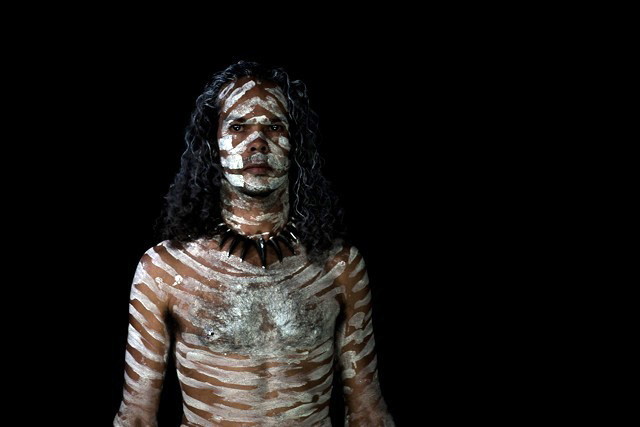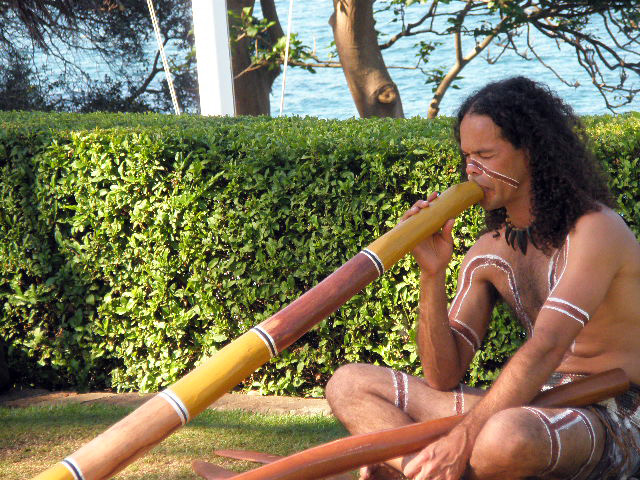
Sean Ryan
In the days when Aboriginal people lived unbothered, nomadic lifestyles, the instrument we now know as the didgeridoo would never have been played in Sydney. In fact, according to Sean Ryan, Aboriginal artist, musician, painter and dancer, the farthest east that the instrument would have traveled was Wujal Wujal, North Queensland, the mother country of the Black Cockatoo people. Apparently the environment east of Wujal Wujal isn’t conducive to termites boring through eucalyptus trees, the key component one looks for when crafting a didgeridoo, more traditionally called a yigi-yigi.
Sean’s also a member of the Black Cockatoo clan, though he was born in Mossman – White Cockatoo country – and has called Sydney home for the last 15 years. It may seem easy enough to concoct a linear story about Sean if you only look in from the outside: born in Mossman, proud Aborigine, traditional didgeridoo player and performer. In fact, his story is far from linear, and it only takes a few moments of sitting with Sean in his Bondi home for me to discover that he didn’t start out with heaps of Aboriginal pride.
“Throughout my teens, I never touched the didgeridoo. I was more interested in bass guitar and things like that,” the now 41-year-old Sean tells me. “Being a teen is a bit awkward, and then being an Aboriginal teenager and a male one at that, there were all these other stigmas that I had to learn to deal with. Being Aboriginal was not something that you did or celebrated or advertised in a big way, especially living in Queensland because there were a lot of racist attitudes.”
It’s not hard to imagine how that environment may dissuade someone from possessing a strong love of their heritage. But things started to shift for Sean in the early 90s when he landed a job making didgeridoos for an artisan in Kuranda. “It was just a little village near Cairns with all these hippies and Aboriginal people from the missions,” he explains.

It turns out that the thing about making didgeridoos is that you have to play them as you’re making them, constantly fine tuning and re-working until the instrument is just right.
“So I was working there, making didgeridoos and hanging out with these fellows, many of whom were my extended family members, and the culture became a very important part of my life.”
By the time he was 20, it was such an important aspect of his identity that he’d packed up and headed to Europe, where he took advantage of his father’s Irish background and scored a European passport. From there, he spent the better part of a decade doing Aboriginal performances and busking on the streets before making his way back to Oz and landing in Byron Bay.
“I’d saved a bunch of money, so I decided to have a big holiday in Byron. I ended up staying for two years, and only left when I saw the money in performing start to dry up.”
It was at that point when he started getting into education as a means to support himself in lieu of artistic support:
“Being an artist in Australia is very difficult. You don’t have appreciation or support in the industry and it can be very cutthroat, so if you do the same thing as someone, there’s a lot of competition,” Sean says. “Because of that, I’ve had to re-package what I do into education.”

These days, Sean creates education programs for schools and for Centennial Park, in addition to regularly performing on stage. Well, except for one part of performing. “I try to avoid dancing at all costs,” he says, laughing. “I’d rather play than sing and dance, so I let the younger fellows dance.”
But lest one think that what Sean does is for entertainment, he’s very quick to point out that his career is not entertainment for entertainment’s sake.
“Everything I do is education. Whenever I get up on stage, I am being representative of the very dignified and intelligent and wise things that my culture can contribute, and already has contributed. What I do is entertaining, and it’s good that people enjoy it because I get to share, but I don’t do it to entertain.”
I can sense Sean’s frustration over the capitalistic nature of “selling his culture,” as he puts it, but I wouldn’t describe his emotion as anger. More so, there’s an undercurrent of sadness, born out of centuries of oppression.
In the end, he tells me, you’ve either got to sink or swim, and this is his way of keeping his head above water in a way that feels right. “I’ve got to put myself in that position in order to create change in the world that I live in. I can’t just sit back in the hills and let things happen. I can’t,” he says. “I wouldn’t do that.”

Given his background, it’s not surprising that Sean admits he’s actually very self-conscious and reserved, but he uses art as a way to break down barriers so he can spread his message.
“The most rewarding part of what I do is in meeting people because it gives me the ability to connect. Sometimes it’s good, sometimes it’s bad, but then sometimes you get these really, really sweet moments.”
He relays a story about a time he was playing didg in a fake cave at Wildlife World when a woman walked in and sat down. “All of the sudden, she just started crying,” he says. “I didn’t know what to do, so I just put my arm around her shoulder while she sobbed.”
The woman had recently lost her husband and after she composed herself, she told Sean that his playing brought back beautiful memories of their life together. “I told her she could stay and when I started to play again, she just sat there staring off into the distance and smiling. She wasn’t there, she was off reliving those memories with her husband. After she left I was a bit choked up,” he admits. “It was really sweet.”
There’s no doubt that anyone who watches Sean play can find meaning and happiness in his music, a uniquely powerful force. But when I ask him how he defines happiness, he pauses.
“It’s not a constant, that’s for sure,” he finally says. “It wouldn’t be good if it was.”
And then he gives me one of the best answers I’ve ever heard to the question:
“For me, happiness is when you come across those little fleeting moments, those little synchronous events that take place when you feel so right in it,” he continues. “It’s those moments of perfection, or of reverence. Those moments that just make you stop and say, yes, that makes sense. That resonates with me. That’s how I define happiness.
Sean Ryan teaches didgeridoo playing at Work-Shop. He also performs regularly around Sydney.